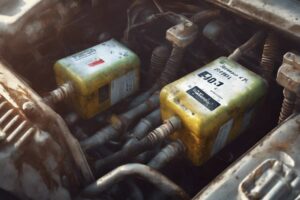Driving with the parking brake on can harm your vehicle. Friction from usage can overheat the brake system, impacting its efficiency. Constant stress on brakes may lead to warping, compromising their effectiveness. Look out for signs like sluggish acceleration and burning odors. Regular maintenance is crucial to preventing costly repairs. Prevent brake damage by not driving with the parking brake engaged. Properly maintaining the brake system is essential to guarantee safe driving. Understanding these effects is critical for vehicle safety and longevity.
What You Need to Know
- Excessive heat damages brake system components.
- Prolonged use leads to brake warping.
- Vigilance prevents costly brake repairs.
- Driving with parking brake on affects performance.
- Regular maintenance prevents brake system issues.
Impact on Vehicle Performance

Driving with the parking brake engaged has a significant impact on your vehicle’s performance by causing excessive friction and heat buildup in the brake system. This can lead to performance degradation, as the brakes are under constant mechanical stress due to the parking brake being on while driving. The heat buildup generated from this action can result in brake warping, where the brake discs or drums become deformed. Such mechanical stress and brake warping can compromise the effectiveness of the braking system and overall vehicle safety.
When the brakes are subjected to prolonged heat due to driving with the parking brake engaged, the brake linings can crack or separate, necessitating potential repairs. Then, the excessive heat can cause the brake fluid to boil, leading to a loss of brake pressure. Ultimately, the combination of these factors can result in brake failure, putting you and other road users at risk. Hence, it’s important to make sure that the parking brake is fully disengaged before driving to prevent these issues.
Signs of Driving With Parking Brake
If you notice a sluggish feeling when accelerating or detect a burning smell near the wheels after driving, these could be signs that the parking brake was engaged. Driving habits play an important role in avoiding such situations.
Engaging the parking brake inadvertently can happen if you forget to release it before driving off. The burning smell near the wheels is a clear indication that the parking brake has been on while driving, causing excess friction and heat buildup.
Mechanical issues can arise from driving with the parking brake engaged. Over time, this can lead to warping of brake discs or drums, necessitating costly repairs. It’s essential to be vigilant and make sure the parking brake is fully disengaged before driving to prevent these issues.
Pay attention to warning signs like the sluggish feeling and unusual smells to avoid potential damage to the brake system. Regularly checking and maintaining your vehicle can help prevent such problems and ensure safe driving conditions.
Brake System Damage

To prevent brake system damage, avoid driving with the parking brake engaged for prolonged periods to minimize wear on rear brake components. Continuous use of the parking brake can lead to premature deterioration of essential parts such as rotors, pads, and wheel bearings. Over time, this can result in increased repair costs as these components may need replacement sooner than expected. Neglecting maintenance tips like releasing the parking brake properly can also lead to overheating and potential warping of brake discs or drums, further escalating repair expenses.
Regularly checking and servicing your braking system can help detect any issues early on, potentially saving you from costly repairs down the line. It’s vital to follow manufacturer recommendations for brake maintenance to ensure peak performance and longevity of your brake components. Remember, taking care of your brakes can’t only save you money in repair costs but also contribute to overall road safety for you and other drivers.
Risks of Overheating
Excessive heat generated from driving with the parking brake engaged can lead to severe damage to your brake system, including warping of brake discs or drums. This heat damage can cause the brake linings to crack or separate, necessitating costly repairs.
When the brakes overheat, the brake fluid can reach boiling point, resulting in a loss of brake pressure and compromised braking performance. By driving with the parking brake on, you create friction that generates heat, potentially damaging essential brake components.
These risks of overheating highlight the importance of regular brake maintenance to prevent such issues. Brake maintenance involves checking for signs of wear, monitoring brake fluid levels, and ensuring proper adjustment of the brake system.
Is Driving with the Parking Brake on Good for Fuel Efficiency?
Driving with the parking brake on can significantly impact your car’s fuel efficiency by reducing acceleration and increasing resistance. This will cause your car to consume more fuel and decrease your running on empty car fuel range. It’s best to always ensure your parking brake is disengaged while driving.
Preventive Measures

Regularly maintaining your parking brake system is vital in preventing jams and malfunctions. Proper maintenance involves checking the condition of the parking brake cables, making sure they aren’t worn or frayed.
Also, inspect the brake pads to guarantee they’re in good condition and have sufficient friction material. Proper engagement and release of the parking brake are essential in preventing accidents and damage. Be sure to engage the brake fully when parked on an incline and release it completely before driving off.
In rear-wheel-drive vehicles, always check for engagement before starting the engine to avoid driving with the parking brake on.
To ensure the effectiveness of your parking brake system, familiarize yourself with proper inspection techniques. Look for any signs of corrosion or rust on the brake components and address them promptly. Newer vehicles may have indicator lights or electric parking brakes that provide added preventive measures.
Safety Concerns
Ensuring the proper functioning of brake indication lights is essential for detecting potential brake circuit failures that can lead to hazardous driving situations. Non-functional brake indication lights can be dangerous, as they may result in undetected brake circuit failures, creating unsafe conditions on the road.
If brake warning lights aren’t working correctly, it becomes challenging to identify crucial issues that could compromise your safety. In the event of brake circuit problems, emergency procedures must be followed promptly to address the issue and prevent any potential accidents. Ignoring these warning signs can have severe consequences, underscoring the importance of regular maintenance checks.
As an Amazon Associate we earn from qualifying purchases.










